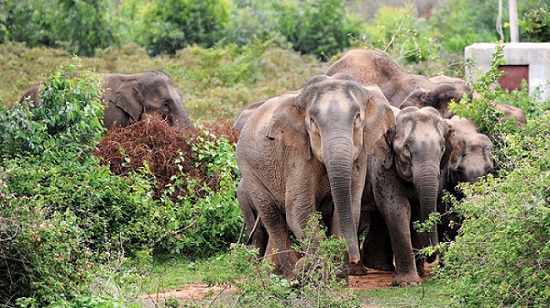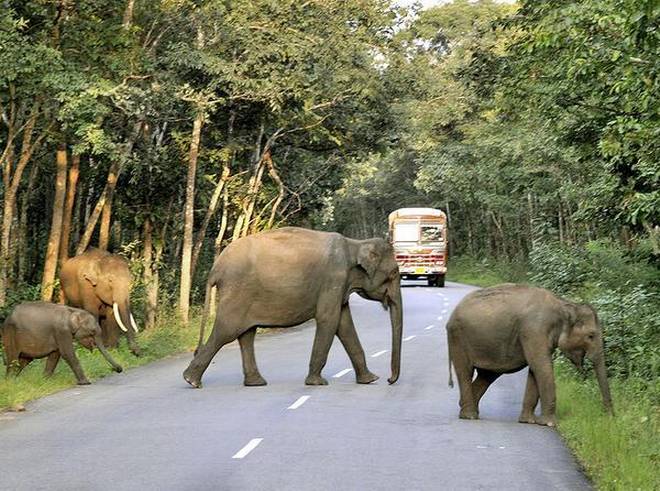A proposed elephant reserve has become the proverbial Achilles’ heel for the Chhattisgarh government which is now faced with a peculiar dilemma: Is an elephant corridor more important than the coal buried deep under earth that India needs very badly?
The previous forest cover for an estimated 260 elephants was 400 square kilometres but now it has been expanded by the Bhupesh Baghel led Congress government five times to almost 2,000 square kilometres, the move triggering protests from tribals living in the vicinity of the forests of the Lemru Elephant Reserve (LER) near the Hasdeo river in the state.
The move came after some intense lobbying by activist groups who wanted the habitat for elephants to cover over 4,000 square kilometres even as a large section of villagers from five districts were against it. The villagers have offered proof that revenue villages have been included in the proposed plan besides many located on the highways. Honestly, it does not make any sense.
The villagers allege that the local administration is pushing them to give nod to the plan in the gram sabha—a mandatory proceeding in the scheduled areas. They villagers are ganging up against such a move. They are in no mood to give up, arguing the elephant project would displace them and also deprive them of the forest rights. Also, a ban on mining and industrial activities will deprive them from the growth opportunities.
The slugfest is turning out to be India’s biggest environmental debate. At the heart of it is the big buck question whether elephants need such a huge forest cover and, equally and importantly, would the state governments now completely stop hawking coal mines located in deep forests.
The Indian government has always been at loggerheads with the country’s environmentalists who have demanded huge tracts of forest cover for the animals. Sadly in India, decisions relating to environmental issues are all political. Worse, political parties – when in power – try their level best to cancel or reverse decisions made by the previous governments. As a result, decisions about expanding or shrinking an animal habitat is always mired in controversies. And sadly, every time the commercial aspect of the cases — ranging from coal and iron ore mines to oil fields — are ignored.

So let’s check some figures here. The per capita electricity consumption in India is estimated at about 1200 units a year and there is a huge disparity between rural and urban areas. It is half of Brazil, one fourth of China and sixth of Russia among BRIC nations. On account of unreliability of much hyped renewable energy, coal is the most economical solution to ensure uninterrupted electricity to 1.3 billion population of India that has fifth largest coal reserves in the world. Also, India is the world’s second largest coal importer after China.
Following protests from the Chhattisgarh government, the Union Ministry of Coal had to rework the list of mines to be auctioned for commercial mining and now 38 blocks will go under the hammer instead of the 41 mines announced earlier. It is important to note here that it has already made a dent in potential royalty revenues for Chhattisgarh where the Congress government has announced ambitious plans for the agriculture sector while it is failing to attract investments into mining and allied industries.
The revision in the list includes addition of three blocks — Dolesara, Jarekela, and Jharpalam-Tangarghat (in Chhattisgarh) — and withdrawal of five blocks in an ecologically sensitive zone near the Hasdeo River: Morga South, Fatehpur, Madanpur (North), Morga-II, and Sayang (in Chhattisgarh).
“Accordingly, 38 coal mines are offered for auction for commercial mining under 11th tranche of auction under the Coal Mining (Special Provisions) Act, 2015, and the first tranche of auction under the Mines and Minerals (Development and Regulation) Act, 1957,” the Ministry of Coal said in a statement.

The Centre had started the coal mine auction — for commercial mining and sale by private companies — in June. The bidding terms were liberalised to attract foreign players, non-mining entities, and large miners. In May, it amended the Coal Mines (Special Provisions) Act, 2015, to simplify the auction process and attract significant investor interest.
In Chattisgarh, one side of the story is about forests and elephants.
The other side revolves around the issue of companies operating coal mines for the state utilities in the area. Among those is the Adani group, which is a mine developer and operator (MDO) — it means the company is developing the mine for someone else and not for itself — in the region. There are close to 40 such contracts under the new generation model of outsourcing where different mining companies operate as MDO contractors for state-owned mining assets. The Ahmedabad-based Adani Group has won mining contracts from the governments of Rajasthan, Maharashtra and Chhattisgarh and has a string of such operations in Chhattisgarh, which has one of the country’s largest coal deposits.
So let us evaluate what Adani is doing in Chhattisgarh. It has won the contracts legally, and is operating legally, there are no illegality issues. If coal has to be mined, it is natural for a company to get rid of trees from the zone and compensate with larger afforestation elsewhere. The coal block operated by Adani is for power generation companies of Rajasthan, Maharashtra and Chhattisgarh government. Adani will not take the coal and sell it for commercial purposes. If private contractor Adani is present in Hasdeo Aranya it needs to be mentioned here that it is because of successive government’s decision to offer the mines to private firms to make most of the country’s nearly five billion tonnes of coal reserves. What is surprising is that the private sector is often pilloried in India by activists and politicians instead of state utilities. For example, the Kolkata-based PSU Coal India, which is the world’s large coal mining firm, also has massive operations in Chhattisgarh but faces no opposition from local activists advocating for Lemru Reserve.

Coal plays an important role in a country’s economy. In India, it accounts for close to half of freight revenues for Indian Railways and it keeps the tariff for passengers low. Also, state governments and local administration earns heavily from royalty and other levies from coal mining firm. For instance, mineral-rich Chhattisgarh alone earned over ₹Rs 14,000 crore as revenue from coal mining in the last five years. Also, mining activities generate huge employment since every direct job in the sector creates 10 more indirect jobs. Short sighted idea of increased area for elephant reserve will have an immense impact on Chhattisgarh economy in the long term as mineral rich districts such as Surguja, Korba and Surajpur in Chhattisgarh while lakhs of locals will lose their forest rights.
So if the plans go through, mining will stop.
The Hasdeo Aranya is a large forested corridor that stretches over 1500 kilometers through central India. No one knows why the government allowed this area to be mined for coal when it was a traditional hub of tribals and elephants. And also, no one knows why the forest cover for the elephants went up five times from 400 to 2000 square kilometres.
If genuine demands of forest covers are met, India will just not be able to mine any minerals from any of its forests.
Consider this one. As per the global estimates, the home range for female Asian elephants can stretch up to 400 square kilometers and almost double that for a male. Unlike the African elephants which are generally savannah inhabitants, Asian elephants tend to travel through dense jungle dwellers. Central India holds 10% of India’s total population of about 27,000 wild elephants.
Now there are some who feel the decision could go horribly wrong and have raised their voices. Among them is Chhattisgarh Health & Rural Development Minister TS Singh Deo, a popular face of Congress in Chhattisgarh. Deo is openly advocating the cause of the villagers. He knows how the entire region of Sarguja had voted Congress in the 2018 state polls to end a 15 year-old BJP rule. Deo is not a greenhorn, he is a root man who helped the Congress party win all 14 seats of Sarguja, his own home. Deo is the titular maharaja of the erstwhile the Sarguja State with deep grass root reach. His stand against the government’s decision has also signaled that all is not well in Baghel government. The Congress party is already in turmoil in neighbouring state Madhya Pradesh where Jyotiraditya Scindia overturned Kamal Nath government to pave path for BJP.
“I will stand with the villagers and I know including the villages located far-away in the elephant reserve has no rationale and no technical logic,” Deo said in a telephonic interview. He said he has already organised as many as 20 Gram Sabhas where he interacted with the villagers to gauge their minds. “All were unanimous that the decision is wrong.” He said he openly told the villagers that they were free to take their own call to either side with the project or oppose it. Deo even assured the villagers that he would join if there was any agitation planned against the move of the state government to expand the forest cover.
“The villagers must be included in the reserve for their livelihood,” said Deo, adding the state government’s decision could soon blow up into a full fledged controversy.
After Deo’s vocal opposition, state forest minister Mohammed Akbar has mellowed down. He issued statements saying that locals will not have to leave their villages on account of Lemru Reserve and the state government will ensure sufficient availability of food and water in the protected areas. “But elephants constantly migrate in search of food and the state government cannot merely offer compensation for losses owing to the human-elephant hostility,” the minister said in a telephonic interview from Raipur.
India needs a genuine answer to its big environmental issue. The nation must decide what should come first: Elephants or Coal?

